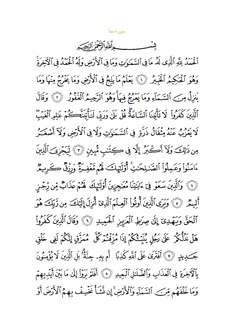Saba (surah)
Saba’ (Arabic: سَبَأ, "Sheba") is the 34th chapter (sūrah) of the Qur'an with 54 verses (āyāt). It discusses the lives of Solomon and David, a story about the people of Sheba, challenges and warnings against the disbelievers as well as the promises related to the Day of Judgment.
| سَبَأ Saba’ Sheba | |
|---|---|
| Classification | Meccan |
| Position | Juzʼ 22 |
| No. of Rukus | 6 |
| No. of verses | 54 |

| Quran |
|---|
 |
|
Regarding the timing and contextual background of the revelation (asbāb al-nuzūl), it is an earlier "Meccan surah", which means it has been revealed in Mecca, instead of later in Medina.
Revelation history
The chapter was revealed during the Meccan period of Muhammad's prophethood, therefore, a Meccan sura. Some commentators of the Quran, including Ahmad ibn Ajiba, Mahmud al-Alusi, Ibn al-Jawzi, and Al-Qurtubi opined that the sixth verse was an exception and was revealed in the Medinan period.[1]
Content
The chapter began with the phrase Alhamdulillah ("Praise be to God"), one of the five chapter where to do so—the others are Al Fātiḥah, Al-An'am, Al-Kahf and Fatir.[2] The first two verses assert God's praiseworthiness and omnipotence.[1] The following verses (3–9) criticized the disbelievers for their rejection of the resurrection, the Day of Judgement and of Muhammad's message.[1][3] The ninth verse also mentions the orderliness of the universe as evidence of God's omnipotence.[4] The following verses (10–14) briefly discuss David and Solomon, both considered prophets by Islam.[1]
Verses 15–19 contain a story about the eponymous people of Sheba.[1] The story is based on the ancient Sabaeans who lived in the central lowlands of Yemen.[5][6] According to the verses, they were originally prosperous, but turned away from worshiping and giving thanks to God, and as a result suffered a flood.[7] The story is presented as a warning against worldly pride and arrogance.[8][1] Orientalist A. F. L. Beeston linked the story to the prosperous Sabeans of the Ma'rib oasis who settled on each side of the wadi (hence the reference to "the garden of the right" and "of the left" in verse 15.[8] Beeston, another orientalist Jérémie Schiettecatte, as well as the Quranic commentary The Study Quran argued that the flood corresponds to the failure of the dam system that irrigated the community.[7][5][8] The dams were mentioned in inscriptions dated from around 450–540 CE, and The Study Quran further argues that the phrase "the flood of 'Arim" correspond to the triliteral root ʿ-r-m that appeared in the inscriptions to refer to the dam system.[7]
The rest of the chapter discusses various topics, including the nature of Iblis (the Devil in the Islamic tradition), challenges to those who reject the message of Islam, warnings of the consequences which will come to them in the Day of Judgement, as well as the nature of Muhammad's mission.[1]
Name
The name of the chapter refers to Sheba, a kingdom mentioned in the Quran and the Bible. Sheba is the subject of the verses 15 to 21 of the chapter, although this passage likely does not refer to the kingdom under the famous Queen of Sheba, but rather about a group of people in the same region in a later period.[1][9] Orientalist A. F. L. Beeston and Jérémie Schiettecatte identified the people in these verses to be the Sabaeans who lived in the Ma'rib valley.[8][5]
References
| Wikisource has original text related to this article: |
Citations
- The Study Quran, p. 1042.
- The Study Quran, p. 1043, v. 1 commentary.
- The Study Quran, pp. 1043–1044, vv. 5–9 commentary.
- The Study Quran, pp. 1044–1045, v. 9 commentary.
- Schiettecatte 2016.
- Beeston 1995, p. 663.
- The Study Quran, pp. 1045–1046, vv. 15–17 commentary.
- Beeston 1995, p. 665.
- The Study Quran, p. 1046, v. 15 commentary.
Bibliography
- Seyyed Hossein Nasr; Caner K. Dagli; Maria Massi Dakake; Joseph E.B. Lumbard; Mohammed Rustom, eds. (2015). The Study Quran: A New Translation and Commentary. New York, NY: HarperCollins. ISBN 978-0-06-112586-7.
- Beeston, A. F. L. (1995). "Sabaʾ". The Encyclopedia of Islam, New Edition, Volume VII: Ned–Sam. Leiden: BRILL. pp. 663–665. doi:10.1163/2214-871X_ei1_SIM_5004. ISBN 90-04-09834-8.CS1 maint: ref=harv (link)
- Schiettecatte, Jérémie (2016). "Sabeans" (PDF). The Encyclopedia of Ancient History. John Wiley & Sons. doi:10.1002/9781444338386.wbeah30170. ISBN 9781405179355.CS1 maint: ref=harv (link)